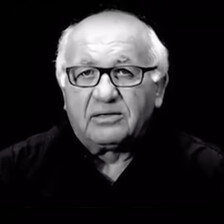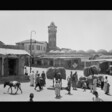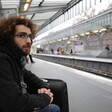The Electronic Intifada 15 May 2006

Palestinian families forced to leave the village of Faluja in 1948. The village was ethnically cleansed by Jewish forces. On its looted lands, Israeli settlers founded Qiryat Gat in 1954. (UN Photo)
In the last week of April 1948, combined Irgun-Haganah forces launched an offensive to drive the Palestinian people out of the beautiful port city of Jaffa, forcing the remaining inhabitants to flee by sea to Gaza or Lebanon; many drowned in the process. My Aunt Rose, a teenager at that time, survived the trip to began her life in exile on the shores of the Lebanese coast.
Each Palestinian refugee family grows up hearing again and again the stories of those final moments in Palestine, the decisions, the panic, as we live in the midst of their terrible consequences. Throughout 1948 Jewish forces expelled many thousands of Palestinians from their villages, towns and cities into Gaza, Lebanon, the West Bank, Syria, Jordan, Egypt, and Iraq. Hundreds of thousands of others fled in fear. The purpose was to create a pure Jewish state ethnically cleansed of the original inhabitants who had lived there for centuries.
The creation of the state of Israel was the heart of this cataclysmic historical event for the Palestinians - the mass forced expulsion of a people, the more than 50 massacres carried out over the summer of 1948 by various armed Jewish forces as a means to drive out others who were determined to stay, the physical demolition of the villages after the expulsions occurred to ensure the refugees could not return, all this is summed up in a single word for Palestinians – nakba, the catastophe.
“We must do everything to ensure they (the Palestinians) never do return…. The old will die and the young will forget” said David Ben Gurion, the founder of Israel, in 1949. But the young have not forgotten. In popular celebrations, rallies, marches, rites of return and commemoration young Palestinians all over the world are marking 58th Nakba Week to remember the catastrophe of 1948, the moment that represents the destruction of Palestine, and the violent dispossession and dispersal of her people.
In refugee camps and university campuses inside and outside of occupied Palestine this week vigils, filmed testimonies, lectures, exhibitions, the recitation of the names of more than 400 destroyed villages in local churches, candlelit poetry readings, organized trips to the ruins of those villages by Palestinians who still live in what became the state of Israel in May 1948 have been organised.
Over the last two weeks Israeli citizens – both Jewish and Palestinian – joined together in almost daily marches, rallies and excursion trips to demolished villages on Zochrot’s Bus 194 (named after the UN Resolution of 1948 calling for the return of the expelled Palestinians to their homes). At a rally on the site of Umm al Zinnat, Salim Fahmawi, now 65, a primary school student when the soldiers entered the village 56 years ago to expel them, told an Israeli reporter: “The presence of so many young people, many of whom are third and fourth generation post-1948, gives me a sense of relief - because I know the torch has not been extinguished and is passing from generation to generation.”
Unlike official ceremonies aimed at reinforcing national identity these Nakba moments have a uniquely dynamic character as the events play a far different role in the lives of Palestinians today. It is not simply the absence of a sovereign state to perform official rites that makes it so (although this is part of the story). Nor does its unique nature lie in the fact that this engine of identity is emerging entirely from the grassroots and driven by the young generation of Palestinian activists (although it is quite remarkable in this respect). Both of these factors point to its unifying feature: unlike other cultural and social manifestations of national identity, this particular affirmation, and the way it is being engaged upon, is profoundly political.
Why is this newly emerging Nakba commemoration so essentially political in its character? It is so because the work it is performing is intimately tied up with the actuality of resistance rather than seeking to enshrine past memories of victimhood. The specific project against the Palestinians begun at the start of the last century had a dual purpose: first to deny the very concept of Palestine and destroy its political and social institutions, and second to annihilate the spirit of the Palestinians as a people, so that they would forget their collective identity once scattered far from Palestine.
Nakba commemoration is not an attempt to institutionalise a historical national trauma or from the fear that this memory will fade when that generation dies. Instead, because of the relentless and dynamic nature of the Catastrophe – because it is an ongoing daily Palestinian experience – the current attempts to destroy the Palestinian collectivity today bind this generation directly to that older one, and bind the exile to the core of the Palestinian body politic. Indeed the last few years have witnessed a phase of violent acceleration in this process of attempted destruction – hence the title of this year’s event: ‘The Nakba continues’.
The Nakba can be seen again today in the brutal thrust of the current policies of the Israeli state. More than 10,000 Palestinian refugees have been created by the construction of the concrete separation wall, condemned by the International Court of Justice as illegal but that nonetheless has expropriated huge new tracts of occupied land. This wall has turned cities like Qalqilya in the West Bank into ghost towns, and thousands of refugees have been created for the third and fourth time in the refugee camps in Gaza over the last five years. Yet it is not simply in the building of the walls and checkpoints by Israeli occupying forces or the different roads created for Jews and Arabs on Arab land, or the use of specially constructed bulldozers that rip up Palestinian orchards and olive groves on a daily basis and demolish hundreds of homes, or the imprisoning of thousands of political prisoners, or the daily murder of Palestinian civilians which demonstrates the relentless consistency, but in the way the total Israeli military and political machinery is dedicated to destroy Palestinian resistance to their project.
This resistance operates on two levels, for the Nakba operated – and operates today – on both. The first is the Palestinians’ physical effort to resist Israeli attempts to dispossess, disinherit, and physically control their land, to get rid of its people and to militarily control and legally disenfranchise those they cannot. The second lies in the Palestinians’ existential affirmation of their identity in the face of a systematic Israeli effort to fragment and destroy it, so that Palestinians will surrender, submit, forget. What is so interesting is that no matter how violently the first method is used by Israel, the second has been a complete failure: Palestinian identity is stronger than ever in 2006.
Nevertheless, the denial of the Palestinians’ right to resist what has been imposed on them has been demonstrated dramatically in recent weeks. We have witnessed the astonishing international policy of imposing sanctions as a form of collective punishment on an occupied people - rather than on their occupier who is maintaining that occupation through brute violence. Vital international aid for basic services has been cut off by the European Union and the US - from Palestinians in the territories occupied by Israel since 1967 - because they elected Hamas, voting for representatives who had campaigned on a platform promising to hold the line against this destruction of their national identity and rights.
The most malicious aspect of this policy is the fact that the money being withheld is only needed because the occupation tactics of curfews, closures and checkpoints have destroyed the Palestinian economy. The financial catastrophe triggered by these sanctions is created entirely by the Israeli occupation itself, as World Bank and British parliamentary select committee reports have made clear.
The punishment of starving the Palestinians is quite blatant: to force them to their knees and make them repudiate their elected representatives. Even more absurdly, Israel has not accepted - or even been asked to accept - any of the parallel conditions being demanded of the Palestinians for a resumption of aid: an end to violence; the acceptance of the 1993 Oslo agreements; or the recognition of a Palestinian state in the territories occupied by Israel in 1967: the West Bank, East Jerusalem and Gaza. Instead they build expand settlements, denounce the Oslo accords, and have used increasingly indiscriminate violence in both Gaza and the West Bank. The west’s response in a conflict it helped created 58 years ago has fallen to a deeply cruel, but also truly bizarre level.
This denial of Palestinians’ worth has been demonstrated again in the way the US and European media studiously ignore their daily suffering. In the months of April and May, over 40 Palestinians have been killed by the army - most of them civilians, at least eight of them children - with the most perfunctory coverage in the western press. Schoolchildren blown to bits in Beit Lahia whilst in the playground, like Mamdouh Obeid; a mother, Eitan Youssef, aged 41 from Tulkarm, shot in front of her children in their house because troops “thought they saw a suspicious movement”; an old man, Musa Sawarkah herding his flock in Gaza gunned down; Zakariya Daraghmeh, a 37 year old taxi-driver “accidentally” shot in the back in Nablus. ; each one a story unheard, untold.
Yet Palestinians’ notion of steadfastness - summoud - for those still on the land itself as perseverance, and in the refusal to abandon the struggle to return for those living outside of it, has re-emerged as forcefully as ever. The inhuman conditions of Al-Shatat – the Palestinian dispersal – which was aimed at the atomisation of collective experience into individualised experiences – is showing itself to have fortified rather than weakened this collective consciousness.
A remarkable regeneration has been occuring on a broad scale. The early steps have been taken in forging a new common platform that can unite Palestinians, in response to the fragmentation of the previous decade during the disconnection of those inside from the outside. The common quest forged by the liberation movement in the 1960s and 70s was also intimately connected with exile and refugees – it launched its platform from exile upon the principles of return and liberation, and had a sense of the Palestinian people both inside and outside of Palestine as one.
The predicament of military occupation is more starkly recognised, but the predicament of exile has its own merciless characteristics, and continues to create its own bitter experience for Palestinians.
Most young Palestinians today live not under military occupation in the West Bank or Gaza, but in the immediate region outside of historic Palestine in the Arab world: stateless, ID-less, jobless, without the international legal protections of other refugees from other countries. Palestinians in the Arab world live in extremely difficult and complex circumstances.
Most difficult for collective organisation is the inability to communicate openly and legally with each other, both within the host countries and across them, to associate collectively and publicly (a particular difficulty for a people with a history of democratic practices); most difficult on a more basic level is the relentless struggle to live any kind of life at all – to find permission to work, travel, register children in local schools, obtain basic health services, a burial permit, a birth certificate, to marry. Millions of Palestinian refugees and exiles also now live in exile in Europe, Canada, and the United States.
This younger generation, wherever they are, possess a common character created through these harsh conditions of exile, and passed on through the overcrowded manifestations of a memory inundated with place names, old liberation songs, photographs of eternally absent relatives, intimate domestic connections and objects – above all the rusted key to the front door of the lost house, never seen. As the French philosopher and sociologist Maurice Halbwachs first noted, human memory can only function within a collective context. In La Mémoire collective, published as Mémoire et société in 1949 four years after he was executed at Buchenwald, Halbwachs was the first to recognize that memory itself is never individual, but always an entirely collective engagement.
Throughout 2005, young Palestinian activists helped to organise over 100 civic meetings in Palestinian refugee camps and exile communities in over 28 countries in order to bring Palestinians together to discuss the things that Palestinians want to do next.
The most promising thing I witnessed at them was watching this generation replicate something they have no first hand acquaintance with themselves, for it is never talked about and is as yet unwritten: the almost secret history of the underground actions of the previous generation of Palestinian resistants. Their current endeavours echo the same practices, the same spirit, and the same inerring direction. And in today’s reclamation project of the Palestinian past of the Nakba, the younger generation retrieve at the same time another history which is also theirs: the still uncollected stories of the previous generations of fighters who also worked in associations, parties, and groups in a similar collective spirit and with an equal passion.
Although these huge meetings held last year were all organised locally, the transcripts of meetings from places as distant from each other as Australia, Iraq, Egypt, Sweden, Lebanon, Canada, Saudi Arabia and Greece showed that a shared conversation is taking place. By some miracle of the general will, every Palestinian has somehow, through all of the different journeys, arrived together at the same place.
Karma Nabulsi is a politics fellow of St Edmund Hall, Oxford University and a former PLO representative. An edited version of this article appeared in The Guardian on 12 May 2006.
Related Links




